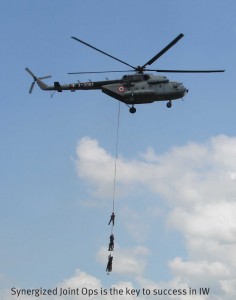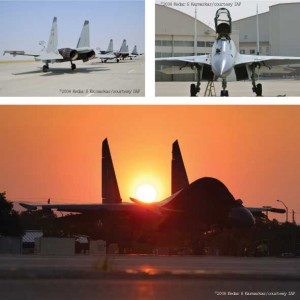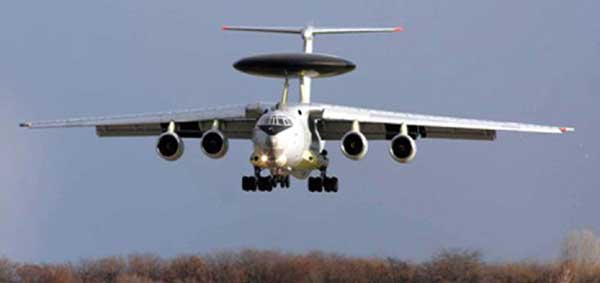Compare the above with the destructive power possible in a land based strike aircraft. It can generate multiple sorties day and night, whereas tank and ship cannot do this with the same rapidity and freedom. The multiple strike sorties are generated each day of the war as long as the aircraft is available, provided it is destroyed by the enemy. Since an aircraft has so much more destructive power, capable of application time and again, over its enormous radius of action -further enhanced by air refueling – the strike aircraft becomes the most precious commodity. Loss of even one aircraft has to be seen as the loss of overall capability that this lone aircraft can provide in multiple sorties, in each day of the war. That is why it is extremely important to control attrition in air warfare.
Because of its speed and vast reach, aircraft offers tremendous flexibility. A strike aircraft can strike at a target located north hundreds of km away in the first sortie, go west in second sortie and yet again switch to a southern target in the night. And now with increasing capability of multiple precise weapons, even in one sortie the same aircraft can strike at many targets located far apart. Can the tank do the same or a naval ship and in same time with same speed? As one compares its relative capability one starts to appreciate the phenomenal strike power and its effect generating ability at target end.
So, in comparison the strike aircraft becomes strategic when related to the capability of tanks and ships. While an army may want three or four Strike Corps – the offensive element for action at different geographical locations, an Air Force can attack in all these areas from one place, because moving a Strike Corps from one area to another takes lots of time and transportation resources and all the while it remains vulnerable to enemy air. During Gulf War 91 – it took the Americans five months to move two armoured corps to Saudi Arabia.
In todays warfare, strategic connotation is no more related either to very long range of bombers or nukes as weapons, but to the effects that are produced at the target end. Aircraft type and the size of bomb is no more a primary consideration.
Whereas the first Squadron of F-15 deployed from USA to Saudi Arabia within 24 hours, flying 15 hours non-stop across the Atlantic and Mediterranean. This is ‘flexibility’. Put very simply, strike aircraft located in centre of India and adequately supported by air refuelling can strike targets all around the Indian border and beyond in the same day, which tanks and naval ships cannot do. This is the flexibility of Air Power with Air Force.
The ‘flexibility’ is also with regard to the roles. A multi-role combat aircraft can perform many roles : strike against targets, air combat with enemy fighters, shooting down enemy’s transport aircraft and helicopters, collecting reconnaissance data on enemy disposition, Sigint and Elint, Jamming of enemy Radar and Radios, Airborne relay or Command Post and so on. No other weapon system can combine so many roles into one platform. Now one can appreciate why the combat aircraft are so phenomenally expensive and the urgent need to minimise attrition to them, and why it takes so much time and resources to train a fighter pilot.
In a similar manner one could compare the artillery guns and the missiles with a combat aircraft. Without going into greater details, it is sufficient to state unambiguously, that in comparison to artillery guns and missiles, a combat aircraft is far more effective.3 Both in accuracy of fire power, repeat sorties and also the cost-effectiveness. No doubt all this demands phenomenal amount of professionalism. That is what separates the Smart Air Forces from the ordinary.
 Having seen the strategic nature of the fire power of the combat arm of the IAF, let us briefly see its strategic nature in airlift and in tremendous mobility offered by Helicopters. The most apt example is the air lift of Para Brigade from Agra to Maldives on 3 Nov 1988. President Gayoom asked India for help to subdue an armed revolt around 0800 hrs. Within 17 hours the first IL-76 carrying lead elements of Para Brigade had landed at Hulule airport of Maldives – a distance of around 3000 km. Or let’s go back to 27 Oct 1947, when the Dakotas of 12 Squadron airlifted vanguard of 1 Sikh from Palam to Srinagar.
Having seen the strategic nature of the fire power of the combat arm of the IAF, let us briefly see its strategic nature in airlift and in tremendous mobility offered by Helicopters. The most apt example is the air lift of Para Brigade from Agra to Maldives on 3 Nov 1988. President Gayoom asked India for help to subdue an armed revolt around 0800 hrs. Within 17 hours the first IL-76 carrying lead elements of Para Brigade had landed at Hulule airport of Maldives – a distance of around 3000 km. Or let’s go back to 27 Oct 1947, when the Dakotas of 12 Squadron airlifted vanguard of 1 Sikh from Palam to Srinagar.
In next 11 days the Dakotas had airlifted 3500 troops. But for this timely airlift -which Lord Mountbatten described as even more remarkable as the “airlift across the Hump” into China -and the valiant actions of the IAF and the IA, Srinagar would have been lost. Similarly airlift for seize of Poonch during 1947-48 ; airlift of troops in May-Jun 48 for defence of Leh ; move of No 5 Division from Palam to Siliguri in Oct 62 ; airlift of stranded Indians from Middle East on the eve of Gulf War – 91 etc. are examples of ‘Strategic’ nature of airlift by IAF.
The helicopter, by its ability to operate from anywhere to anywhere has given a new meaning to mobility by an Air Force. The most apt example is the helilift of army troops on 7 Dec 1971 across vast rivers of then East Pakistan at Sylhet. Again on 8 Dec, the No 105 and 110 HU airlifted Indian Army troops across Meghna river – because the retreating Pakistanis had blown up the bridge. Another sterling example is between 13-17 Apr 1984. During this period our helicopters helilanded Indian Army troops at dominating positions on Saltoro Ridge, thus giving them domination of Siachen Glacier. And it was the phenomenal mobility and fire power of our helicopters in Sri Lanka during IPKF operations that enabled Indian Army to successfully accomplish its task. That Srilankan problem continues even today, has little to do with our military performance.
 As one looks at advances in air power capability and its virtue of stealth, precision, increasing speed and range, and contribution of space, one can understand the increasing ‘strategic’ nature of Air Power, thus of the IAF.
As one looks at advances in air power capability and its virtue of stealth, precision, increasing speed and range, and contribution of space, one can understand the increasing ‘strategic’ nature of Air Power, thus of the IAF.
The ‘strategic’ nature of IAF / modern Air Forces can be summarised in their core competencies. These are:
- Air Superiority.
- Space Superiority.
- Precision attacks over vast distance.
- Rapid mobility over large distance.
- Three dimensional ability to over fly obstacles, adverse terrain, ground defences etc.
- Ability to strike at almost all targets.
- Rapid ability to undertake multiple strikes. This translates into fighting many battles simultaneously / sequentially through out the war.
- Swift war making.
- Control over escalation/descalation of war by rapid movements IN/OUT of Air Force from Theatre of Combat.
- Enabler of Information Superiority.
Air Forces capable of doing above tasks require vast resources for cutting-edge equipment; the best human material for pilots and support staff; rigorous training in near real op time scenarios. And above all lot of lead time. A nation that ignores this aspect stands to be devoid of this instrument of ‘Strategic Choice’.
Endnotes
- Willim Green, “IAF and It’s Aircraft” (Chevron Press, Leicester, England, 1982), p.67.
- Richard T Reynolds, “Heart of the Storm – The Genesis of the Air Campaign against Iraq” (Air University Press, Maxwell Air Force Base, Alabama, 1995),p.107.
- For detailed analysis on effectiveness comparison between strike aircraft and missiles see – Christopher J Bowie, “Trends in the Global Balance of Air Power” – R AND AF Project 1995.






whilst doctrine may be good THE Indian AIRFORCE HAS LOST THE BATTLE AS FAR AS THE LOCAL AND INDIGENOUS MANUFACTURE OF BOTH FIGHTER AND ATTACK CHOPPERS IS THERE . OF THE 700 HUNDRED ODD FIGHTERS VERY FEW INFACT NEGLIGIBLE ARE OF INDIAN DESIGN OR MAKE . THE TIME TO START IS NOW WITH THE LCA AND KEEP UPGRADING IT TO MK1A, 2 ,3 ,4 TILL IN NEXT 10 YEARS THE FORCE HAS THE ULTIMATE LIGHTWEIGHT FIGHTER AND BUILT FOR SWAMPING THE PAK AND CHINESE WITH 600 VARIANTS IN 30 SQUNS . THE AMCA MUST BE PRODUCTIONISED BY 2025 AND FINALLY A HEAVY 5TH 0R 6TH GEN T-50 WITH INDIAN INPUTS TO COMPLETELY DELINK THE ARMS MAFIA AND IMPORTS . TRANSPORT AND OTHER AIRCRAFT NEED TO BE BUILT IN INDIA WITH COMMERCIAL AND DEFENCE MROS BEING SET UP AND AMERICAN LOCKHEED MARTIN , BOEING , GE , PRAT AND WHITNEY NORTHROP GRUMAN AND OTHERS WITH ROLLS ROYCE EURO CONSORTIUM , FRENCH AND GERMAN COMPANIES GIVEN LIBERAL CONCESSIONS TO SET UP MANUFACTURING UNITS IN INDIA TO REDUCE COSTS AND BUILD UP INDIAN AERO DESIGN PRODUCTION , MANUFACTURING , TESTING TRIALS AND COMMSSIONING ENTERPRISES THEREBY PROVIDING JOBS TO MILLIONS OF ENGINEERS BEING TURNED OUT . The airforce as of today is a FULLY imported one though 4th largest but the sustaining power and war wastage reserves are few and almost neglible
The advantages of air force in the military depend upon the favourable circumstances that exist and are opportune. Of course, I wasn’t in Afghanistan during the Soviet-Afghan war, but it seems that air power was made redundant for the way the Soviet forces wanted to use the same. It must have seen to be overkill for the Soviets to send aircraft to combat small groups of Mujahideen fighters. The Soviet aircraft could not use their long range combat capabilities to target the Afghan fighters. The Soviets also didn’t use their heavy lift helicopters to bring their soldiers to engage the Afghan rebels. I think the Soviets didn’t want to engage in close combat with the Afghan rebels.
Did the U. S. help the Afghans in their tactics against the Soviets? The Taliban were not very successful in their war against the United States armed forces. In the recent conflicts where air power was used, it seemed as if air power was very underwhelming because of the impact that it had on the enemy. Because of the improvements in the weapons that the infantry has access to today, allowing them to operate in small groups and numbers, the military aircraft can only have limited impact on the operational battlefield.
It’s not impossible to install anti-missile defences against enemy missiles, and the same is true for enemy aircraft as well.
In my earnest opinion, what determines the outcome of military conflicts is the number of boots on the ground, and how air forces support the same.
The helicopters were used extensively during the Soviet- Afghan war, mainly for bombing Mujahideen fighters. When the U.S. supplied heat-seeking missiles to the Mujahideen, the Soviet Mi-8 and Mi-24 helicopters proved to be favorite targets of the rebels. USA started using UAV instead of helicopter in Afghanistan to escape from the hits of their own weapons used by Taliban
Your article has exposed the bad planning of IAF. You have said that the destructive power of the each bomb has increased. and one fighter plane can carry more number of bombs. This automatically bring down the number of sorties in any future wars. Fighter plane is only weapon carrying vehicle. If that is the case why do you require 42 squadrons In 1971 war IAF had only 34 effective squadrons, each of which consisted of 12 planes . IAF had 16 air craft per combat squadron but the effective availability during the 1971 war was 12 per squadron. So in 1971 IAF had 408 effective planes. Now we have 582 effective fighter planes.
SU-30 MKI 224
Jaguar 145
MIg 27 85
Mig 29 89
Mirage 59
Total 582
In 1971 war IAF used two planes to conduct one sortie. Front plane is called front gunner and other plane is called rear gunner. Those days front gunners had to do so many operations at a time particularly at the time of dog fight. Tejas can conduct sortie without gunner because it has been provided with AESA avionic of Israeli design . If we use AWACs, all our fighter planes can conduct sorties without escort plane. AWACSs will give warning . Now we have double the fire power over a period of time. More over if we consider 12 fighter planes in a squadron, it is stated that we have 48 .5 squadrons. If we consider 16 fighter planes in a squadron, we have now 36 squadrons. The important thing is to consider the number of planes, not the squadrons. This is the kind of tricks they play against the civilian Govt. with the help of foreign agents. There no necessity for Rafael plane which you are hankering for. More over we have power full missiles to take care the army. So there some thing wrong in your calculation of requirements of planes. Your requirement of planes should be based on the destructive power of the weapon. and number of such weapons a plane can carry. So all your demands are inflated without proper study. None of the fighter planes will be able to escape from multiple missile attack.s. Instead of spending billions of dollars we should manufacture more missiles and its avionic. None of the USA fighter planes will be able to escape from S-400 missiles and a new digital Jammer developed by Russia. That is the main reason USA is avoiding direct confrontation with Russia. Now Russia is directly involving Syria. But USA is keeping quite. The same case with China and Ukraine. 21st century is for missiles and not fighter planes.
Why did you include the USSR in the list of nations who lost in World War 2 ?
The IAF should actually be disbanded and merged into the army and navy. The IAF is no good; it seldom cooperates with the army and military, so the IAF can actually hurt a war effort rather than help it. Don’t worry, IAF guys, you’ll still retain your pilots and marshals.